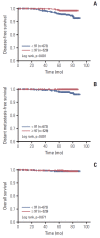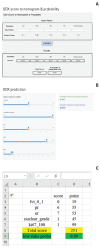A Nomogram for Predicting the Oncotype DX Recurrence Score in Women with T1-3N0-1miM0 Hormone Receptor‒Positive, Human Epidermal Growth Factor 2 (HER2)‒Negative Breast Cancer
- PMID: 30384581
- PMCID: PMC6639212
- DOI: 10.4143/crt.2018.357
A Nomogram for Predicting the Oncotype DX Recurrence Score in Women with T1-3N0-1miM0 Hormone Receptor‒Positive, Human Epidermal Growth Factor 2 (HER2)‒Negative Breast Cancer
Abstract
Purpose: This preliminary study was conducted to evaluate the association between Oncotype DX (ODX) recurrence score and traditional prognostic factors. We also developed a nomogram to predict subgroups with low ODX recurrence scores (less than 25) and to avoid additional chemotherapy treatments for those patients.
Materials and methods: Clinicopathological and immunohistochemical variables were retrospectively retrieved and analyzed from a series of 485 T1-3N0-1miM0 hormone receptor-positive, human epidermal growth factor 2‒negative breast cancer patients with available ODX test results at Asan Medical Center from 2010 to 2016. One hundred twenty-seven patients (26%) had positive axillary lymph node micrometastases, and 408 (84%) had ODX recurrence scores of ≤25. Logistic regression was performed to build a nomogram for predicting a low-risk subgroup of the ODX assay.
Results: Multivariate analysis revealed that estrogen receptor (ER) score, progesterone receptor (PR) score, histologic grade, lymphovascular invasion (LVI), and Ki-67 had a statistically significant association with the low-risk subgroup. With these variables, we developed a nomogram to predict the low-risk subgroup with ODX recurrence scores of ≤25. The area under the receiver operating characteristic curve was 0.90 (95% confidence interval [CI], 0.85 to 0.96). When applied to the validation group the nomogram was accurate with an area under the curve = 0.88 (95% CI, 0.83 to 0.95).
Conclusion: The low ODX recurrence score subgroup can be predicted by a nomogram incorporating five traditional prognostic factors: ER, PR, histologic grade, LVI, and Ki-67. Our nomogram, which predicts a low-risk ODX recurrence score, will be a useful tool to help select patients who may or may not need additional ODX testing.
Keywords: Breast neoplasms; Nomogram; Oncotype; Prediction; Prognosis; Recurrence.
Conflict of interest statement
Conflict of interest relevant to this article was not reported.
Figures




References
-
- Rosenberg J, Chia YL, Plevritis S. The effect of age, race, tumor size, tumor grade, and disease stage on invasive ductal breast cancer survival in the U.S. SEER database. Breast Cancer Res Treat. 2005;89:47–54. - PubMed
-
- Fisher B, Bauer M, Wickerham DL, Redmond CK, Fisher ER, Cruz AB, et al. Relation of number of positive axillary nodes to the prognosis of patients with primary breast cancer. An NSABP update. Cancer. 1983;52:1551–7. - PubMed
-
- Baak JP, Gudlaugsson E, Skaland I, Guo LH, Klos J, Lende TH, et al. Proliferation is the strongest prognosticator in node-negative breast cancer: significance, error sources, alternatives and comparison with molecular prognostic markers. Breast Cancer Res Treat. 2009;115:241–54. - PubMed
-
- Elston CW, Ellis IO. Pathological prognostic factors in breast cancer. I. The value of histological grade in breast cancer: experience from a large study with long-term follow-up. Histopathology. 2002;41:154–61. - PubMed
MeSH terms
Substances
Grants and funding
LinkOut - more resources
Full Text Sources
Medical
Research Materials
Miscellaneous

